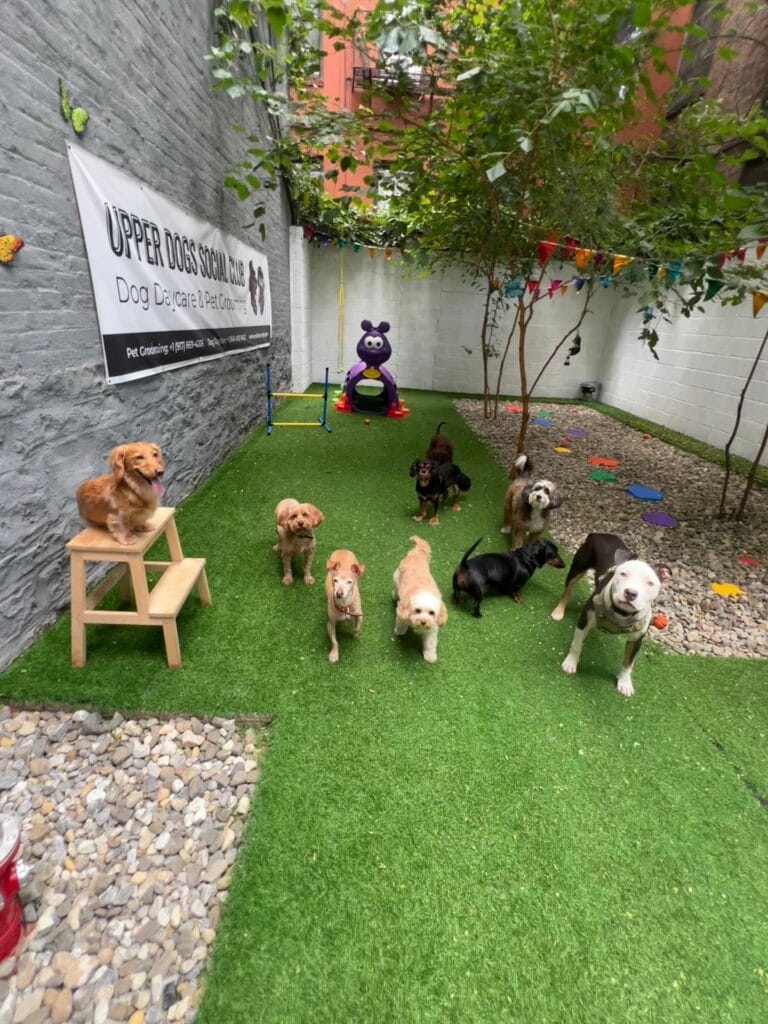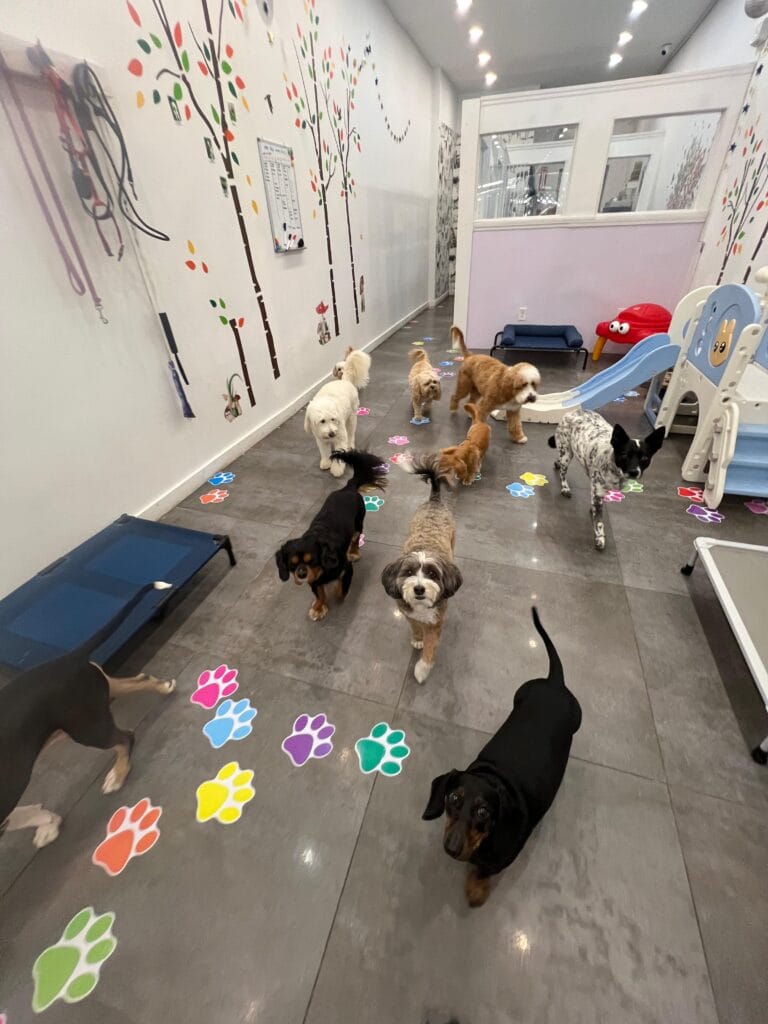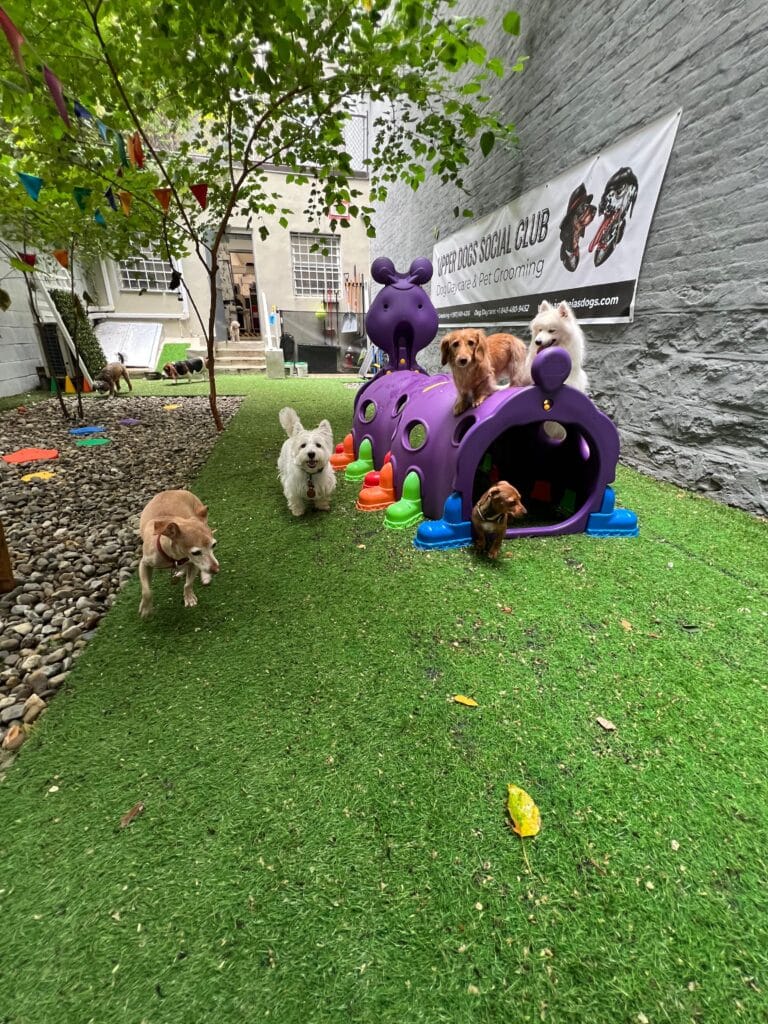Working long hours in NYC while owning a dog creates a daily dilemma that millions of busy professionals face. You love your furry companion, but your demanding career leaves little time for midday walks, proper exercise, or the socialization your dog needs to stay happy and healthy. For those based uptown, exploring Dog Daycare in East Harlem, Manhattan NYC can be an especially practical solution that supports both your schedule and your pet’s well-being.
This guide is written specifically for NYC professionals who want to provide excellent care for their dogs without sacrificing their career goals. Dog daycare solutions offer a practical answer that benefits both you and your pet.
We’ll explore why the demanding pace of professional life in New York makes dog daycare more essential than ever, and break down the key services that quality facilities provide to keep your dog thriving. You’ll also learn how to evaluate different daycare options to find the perfect fit for your dog’s personality and needs, plus get a realistic look at costs versus the valuable benefits you’ll receive.
Why NYC Professionals Need Dog Daycare More Than Ever
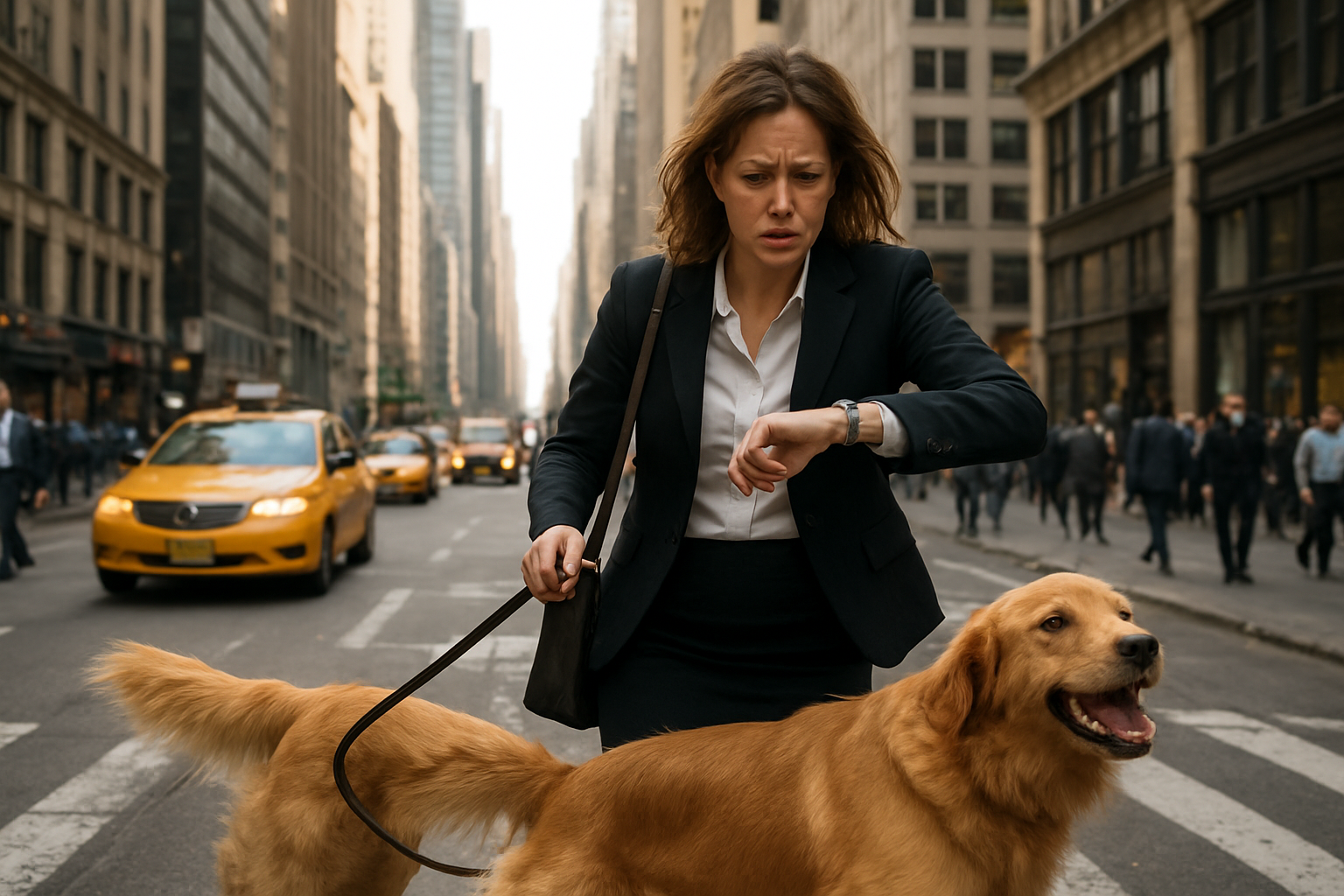
Demanding work schedules and long commute times
NYC professionals face some of the most grueling work schedules in the country. According to the U.S. Bureau of Labor Statistics, the average Manhattan employee works around 49 hours per week, with many investment bankers, lawyers, and tech professionals clocking 60–80 hours regularly. When you add the notorious New York commute—averaging 41 minutes each way—dogs are left alone for 10-12 hours daily.
This extended isolation creates serious behavioral and health issues. Dogs left alone for such long periods often develop separation anxiety, leading to destructive behaviors like chewing furniture, excessive barking, or house training regression. Without proper exercise and mental stimulation during these marathon workdays, pets become restless and difficult to manage during the few hours owners are home.
The “lunch break walk” that works in suburban settings simply doesn’t exist for most NYC professionals. Building security, elevator waits, and the sheer distance from office to home make midday visits impossible. Many workers barely have time to grab lunch, let alone rush home to walk their dogs.
Weekend warrior syndrome becomes the norm—trying to cram a week’s worth of exercise and attention into two days. This sporadic attention pattern confuses dogs and fails to meet their daily needs for consistency, routine, and social interaction.
Limited outdoor space in urban apartments
Manhattan apartments average just 866 square feet, with many studio and one-bedroom units offering even less space. Dogs, regardless of size, need room to move, play, and express natural behaviors. A Border Collie cramped in a 500-square-foot studio faces the same space constraints as a Great Dane, just on different scales.
Urban apartments lack backyards where dogs can freely run, dig, or simply enjoy outdoor time without leashes and restrictions. The closest outdoor space often means navigating crowded sidewalks, dodging traffic, and competing with hundreds of other dog owners for small patches of grass in local parks.
Dog runs in NYC parks are frequently overcrowded, especially during peak hours when most pet owners are available. NYC Parks, which manages dog runs across the city, notes the heavy usage of these designated spaces, with Central Park’s runs often seeing over 100 dogs during busy periods. Many smaller neighborhood parks close their dog runs during winter months or for maintenance, further limiting options.
Weather presents another challenge. NYC’s harsh winters, with temperatures dropping below freezing for months, make outdoor exercise uncomfortable for both dogs and owners. Snow, ice, and salt on sidewalks can injure paw pads, while summer heat creates dangerous conditions on hot pavement. Indoor apartment life becomes even more confining during these extreme weather periods.
Rising pet ownership among young professionals
The pandemic accelerated pet adoption rates among NYC professionals by 250%, with millennials and Gen Z leading this trend. Remote work initially made pet ownership seem manageable, but return-to-office mandates have created a crisis for these new pet parents who never planned for full-time office schedules.
Young professionals often choose dogs as starter families, providing companionship in expensive, isolating urban environments. However, many underestimate the time, energy, and logistics required for proper pet care while maintaining demanding career trajectories. The Instagram-worthy puppy photos don’t capture the 5 AM wake-up calls, emergency vet visits, or the stress of finding last-minute pet care for work trips.
NYC’s rental market adds complexity to pet ownership. Many apartments have strict breed restrictions, weight limits, or require substantial pet deposits. Young professionals often move frequently for career advancement, making stable pet care arrangements challenging. Each relocation means finding new veterinarians, dog parks, and rebuilding social networks for both owner and pet.
Career advancement often demands increased travel, longer hours, or relocation opportunities that conflict with pet ownership responsibilities. Without established support systems like family nearby, young professionals find themselves choosing between career opportunities and pet welfare—a choice that quality daycare services can help eliminate.
Related Article
What to Expect from a Premier Dog Daycare in Manhattan
How Often Should Your Dog Attend Daycare in Manhattan NYC?
Essential Services That Quality Dog Daycares Provide
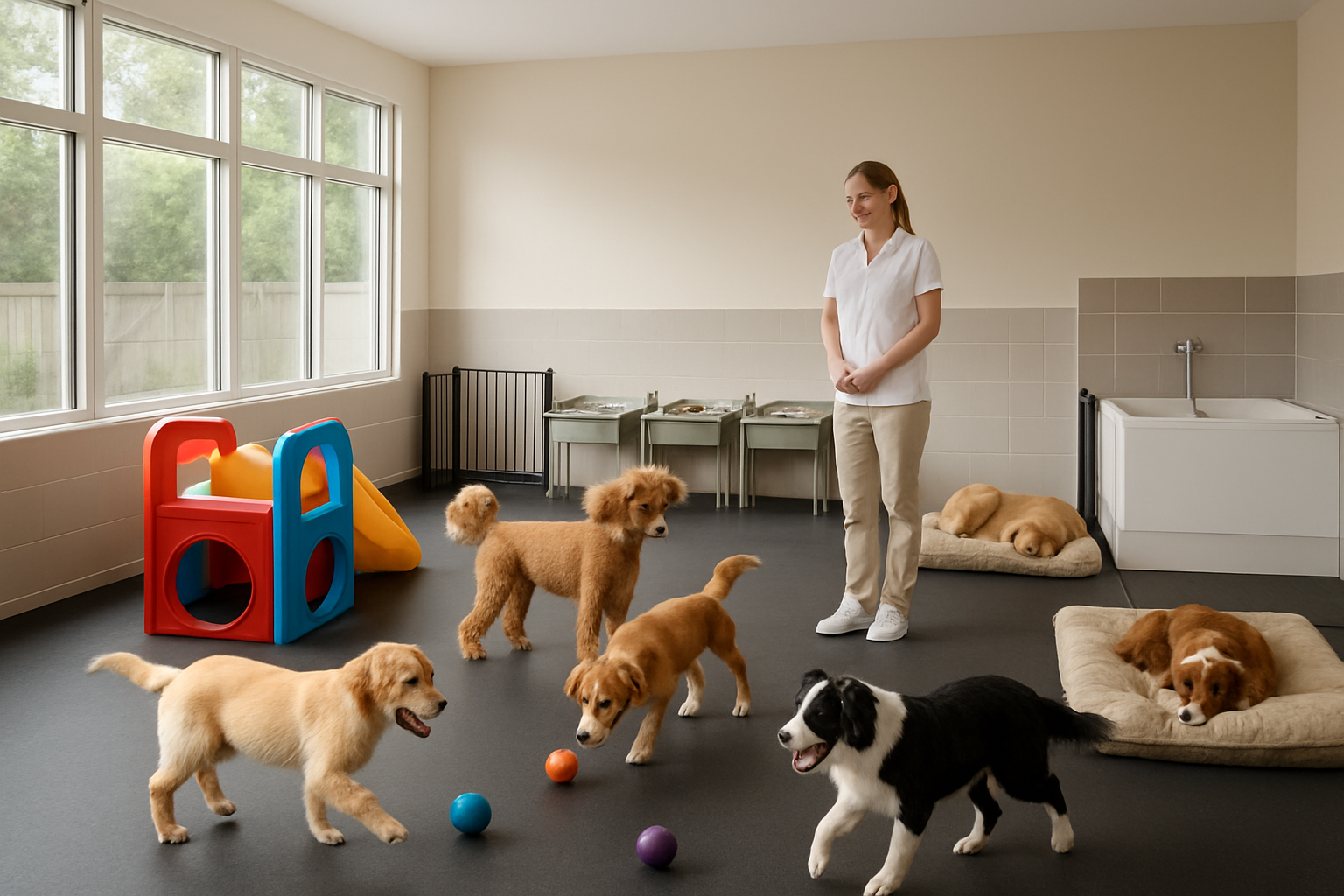
Supervised Playtime and Socialization Opportunities
Quality dog daycares create controlled environments where your pup can interact with other dogs safely. Staff members actively monitor playgroups, separating dogs by size, temperament, and energy levels to prevent conflicts and ensure everyone has a good time. Dogs learn proper social cues through these interactions – like when another dog wants space or is ready to play.
The benefits go way beyond just burning energy. The American Veterinary Medical Association highlights that dogs who regularly socialize tend to be more confident around strangers and other animals, picking up on body language better and becoming less reactive to new situations. This social education is especially valuable for NYC dogs who encounter countless people, pets, and urban stimuli daily.
Most reputable facilities rotate playgroups throughout the day, giving dogs variety in their social interactions. Some offer specialized sessions for shy dogs or puppies who need gentler introductions. Staff trained in canine behavior can spot early warning signs of stress or overstimulation, stepping in before minor scuffles escalate.
Professional Exercise Programs Tailored to Breed Needs
Different breeds have vastly different exercise requirements, and top-tier daycares recognize this. The American Kennel Club provides detailed guidance showing that a Border Collie needs intense mental and physical stimulation, while a Bulldog requires shorter, less strenuous sessions. Quality facilities assess each dog individually and create exercise plans that match their specific needs.
High-energy breeds might participate in agility courses, fetch sessions, or structured running time. Working breeds often benefit from puzzle toys and problem-solving activities that engage their minds. Smaller or older dogs might enjoy gentle walks, swimming sessions, or low-impact play that keeps them active without overexertion.
Many daycares employ certified dog trainers who understand breed characteristics and can modify activities accordingly. They track each dog’s progress and adjust routines based on age, health conditions, and personal preferences. Some facilities even offer specialized services like underwater treadmill sessions for dogs recovering from injuries or dealing with arthritis.
Bathroom Breaks and Accident Prevention
Professional daycares maintain strict schedules for potty breaks, typically every 2-3 hours depending on the dogs’ ages and needs. Puppies and senior dogs often require more frequent opportunities, and quality facilities accommodate these individual requirements without question.
Staff members monitor dogs for signs they need to go outside – pacing, whining, or moving toward exits. This proactive approach prevents accidents and reinforces good bathroom habits. Many daycares keep detailed logs of each dog’s bathroom schedule, helping owners understand their pet’s patterns and maintain consistency at home.
Indoor accidents happen, but professional facilities clean and sanitize immediately using pet-safe products. They understand that stress or excitement can affect even well-trained dogs, so there’s never punishment involved. The goal is maintaining a clean, hygienic environment while supporting each dog’s natural rhythms and needs.
Related Article
Boosting Social Skills: How Dog Daycare Benefits Your NYC Pup
How to Choose the Right Daycare for Your Dog

Location Convenience and Pickup/Drop-off Options
Your morning commute is already complicated enough without adding a detour across town to drop off your furry friend. Smart NYC professionals prioritize daycare facilities within a reasonable distance from their home or office – ideally no more than 10-15 minutes out of your way.
Look for daycares that offer flexible pickup and drop-off windows. The best facilities understand that city schedules don’t always align with standard 9-to-5 routines. Some premium locations provide early morning drop-offs as early as 6:30 AM and late pickups until 8 PM or later. This flexibility becomes invaluable during those inevitable late meetings or subway delays.
Many top-tier daycares now offer shuttle services for an additional fee, picking up dogs from specific neighborhoods or apartment buildings. While this costs extra, the time savings and stress reduction often justify the expense for busy professionals juggling demanding careers.
Consider proximity to subway stations or major bus routes if you’re using public transportation. Some daycare owners have partnered with local pet taxi services, creating seamless transportation solutions that eliminate the need for you to handle logistics personally.
Staff Qualifications and Dog-to-Caregiver Ratios
The quality of care your dog receives directly correlates with staff expertise and attention levels. Reputable daycares employ team members with formal training in animal behavior, pet first aid certification, and experience managing group dynamics among dogs.
Ask about staff-to-dog ratios during your facility tour. Industry standards suggest no more than 10-12 dogs per caregiver for small breeds, and 6-8 dogs per handler for larger breeds. These numbers ensure adequate supervision and quick intervention if conflicts arise.
Key Staff Qualifications to Verify:
- Pet CPR and first aid certification
- Previous experience in veterinary clinics or animal shelters
- Training in dog behavior assessment and conflict resolution
- Background checks and insurance coverage
- Continuing education in animal care practices
Watch how staff members interact with the dogs during your visit. Professional caregivers should demonstrate calm confidence, use positive reinforcement techniques, and show genuine enthusiasm for working with animals. Red flags include staff who seem overwhelmed, use harsh correction methods, or appear disinterested in individual dogs’ needs.
Facility Cleanliness and Safety Protocols
A clean facility reflects management’s commitment to your dog’s health and safety. During your tour, pay attention to odors, floor conditions, and overall hygiene standards. Professional daycares maintain rigorous cleaning schedules with pet-safe disinfectants and proper waste management systems.
Safety protocols should include secure fencing, double-door entry systems to prevent escapes, and separate play areas for different dog sizes and temperaments. Guidance from the Centers for Disease Control and Prevention also underscores the importance of maintaining proper vaccination records and disease-prevention standards in animal care environments.
Essential Safety Features:
| Feature | Why It Matters |
|---|---|
| Double-gate entry | Prevents escape during arrivals/departures |
| Non-slip flooring | Reduces injury risk during play |
| Secure outdoor areas | Safe exercise without escape risks |
| Emergency protocols | Quick response to medical situations |
| Vaccination requirements | Disease prevention measures |
Ask about emergency procedures, including veterinary partnerships and evacuation plans. The best facilities maintain detailed health records for each dog and require current vaccination documentation before admission.
Related Article
Prioritizing Safety: Dog Daycare Protocols in Urban Environments
Cost-Benefit Analysis of Dog Daycare Investment

Preventing Destructive Behavior and Property Damage
Dogs left alone for extended periods often channel their energy and anxiety into destructive behaviors that can cost NYC professionals thousands of dollars. A bored German Shepherd might chew through a $3,000 leather couch in an afternoon, while an anxious rescue dog could scratch hardwood floors or destroy custom cabinetry. Manhattan apartment dwellers face particularly steep replacement costs, with designer furniture and limited space making every damaged item expensive to replace.
Regular daycare attendance dramatically reduces these incidents. Dogs receive physical exercise, mental stimulation, and social interaction that leaves them contentedly tired at home. Professional dog daycares report that clients see 80-90% reductions in destructive behaviors within the first month of enrollment. The math becomes clear when you compare a $50-70 daily daycare fee against replacing a $2,500 sectional sofa or repairing clawed-up crown molding.
Property damage extends beyond furniture. Dogs have destroyed security deposits by scratching doors, chewing baseboards, and having accidents on expensive rugs. Brooklyn renters report losing entire deposits ranging from $2,000-5,000 due to pet damage, while Manhattan co-op owners face costly repairs that affect property values.
Reducing Veterinary Bills Through Exercise and Socialization
Proper exercise and socialization directly impact your dog’s long-term health costs. Sedentary dogs develop obesity-related conditions including diabetes, joint problems, and heart disease that require expensive ongoing treatment. A diabetic dog needs insulin shots, special food, and frequent vet visits that easily cost $200-400 monthly.
Well-exercised dogs maintain healthier weights and stronger cardiovascular systems. Dog daycares provide structured physical activity that most working professionals cannot match. Dogs get 4-6 hours of supervised play, walks, and activities that keep their bodies in peak condition. This consistent exercise regimen helps prevent costly orthopedic issues and keeps metabolism functioning properly.
Socialization benefits prove equally valuable financially. Dogs that interact regularly with other animals and people develop better behavioral patterns and reduced anxiety. Poorly socialized dogs often require expensive behavioral training, anti-anxiety medications, or specialized veterinary behaviorist consultations. These interventions can cost $150-300 per session, with treatment plans extending months or years.
Well-socialized dogs also experience less stress-related health issues. Chronic stress weakens immune systems, leading to frequent illnesses and higher vet bills. Daycare dogs typically show stronger immune responses and fewer stress-related digestive problems.
Comparing Daycare Costs to Dog Walkers and Pet Sitters
NYC dog daycare costs vary significantly by neighborhood and services offered. Manhattan facilities typically charge $60-90 per day, while Brooklyn and Queens options range $40-70 daily. These prices include full-day care, meals, exercise, and socialization.
| Service Type | Daily Cost | Weekly Cost (5 days) | Annual Cost |
|---|---|---|---|
| Premium Manhattan Daycare | $80-90 | $400-450 | $20,800-23,400 |
| Standard NYC Daycare | $50-70 | $250-350 | $13,000-18,200 |
| Professional Dog Walker (2 visits) | $60-80 | $300-400 | $15,600-20,800 |
| Live-in Pet Sitter | $100-150 | $500-750 | $26,000-39,000 |
Dog walkers provide shorter interaction periods, typically 30-60 minutes twice daily. While this meets basic exercise needs, it doesn’t offer the comprehensive benefits of full-day socialization and structured activities. Many professionals hire walkers for lunch breaks and evening visits, creating costs comparable to daycare without the extensive benefits.
Pet sitters offer personalized attention but at premium prices. Overnight sitting in NYC ranges $100-150 nightly, making extended work trips or vacations extremely expensive. Daycare facilities often provide discounted boarding rates for existing clients.
The value proposition becomes clearer when factoring in convenience and peace of mind. Daycare eliminates the hassle of coordinating multiple service providers, reduces scheduling conflicts, and provides professional oversight that individual contractors cannot match.
Related Article
Preparing Your Dog for Their First Day at Manhattan Daycare
Conclusão

Living in NYC with a demanding career doesn’t mean you have to sacrifice your dog’s happiness or your peace of mind. Quality dog daycare centers offer busy professionals a practical solution that benefits everyone involved. Your furry friend gets the socialization, exercise, and attention they crave while you focus on your work without guilt or worry about destructive behavior at home.
When you’re weighing the costs against the benefits, remember that dog daycare is more than just pet sitting – it’s an investment in your dog’s physical and mental health, your career productivity, and your overall quality of life. As you explore your options, learning more about Pet Care Services in Manhattan, NYC can help you understand the full range of support available. The right daycare will feel like a second home for your dog and give you the confidence to tackle your busy schedule knowing your best friend is in excellent hands.
Frequently Asked Question (FAQs)
If your dog is alone for more than 6–8 hours a day, shows signs of boredom or anxiety (chewing, barking, pacing), or struggles with pent-up energy in the evenings, daycare can make a big difference. Busy NYC schedules and long commutes often make regular midday care impossible, making daycare an ideal solution.
Most reputable daycares separate dogs by size, temperament, and energy level to maintain a safe environment. Shy, senior, or high-energy dogs can all benefit as long as the facility is experienced in managing diverse groups. Always ask about staff training and dog-to-caregiver ratios.
Prices vary by borough and services offered. On average:
Manhattan: $60–$90/day
Brooklyn/Queens: $40–$70/day
Many facilities offer weekly packages or membership discounts, which can reduce overall cost.
Key factors include cleanliness, staff qualifications, safety protocols, dog-to-caregiver ratios, vaccination requirements, and convenience to your home or office. Scheduling a tour and observing how the staff interacts with dogs is the best way to evaluate a facility.
Regular daycare improves socialization, reduces anxiety, prevents destructive behavior at home, and supports physical and mental health. Over time, many owners notice better behavior, fewer vet bills related to stress or inactivity, and a happier, more confident dog.




